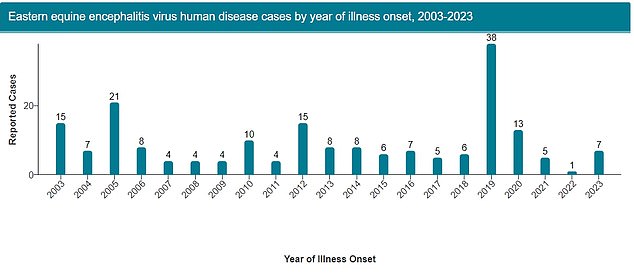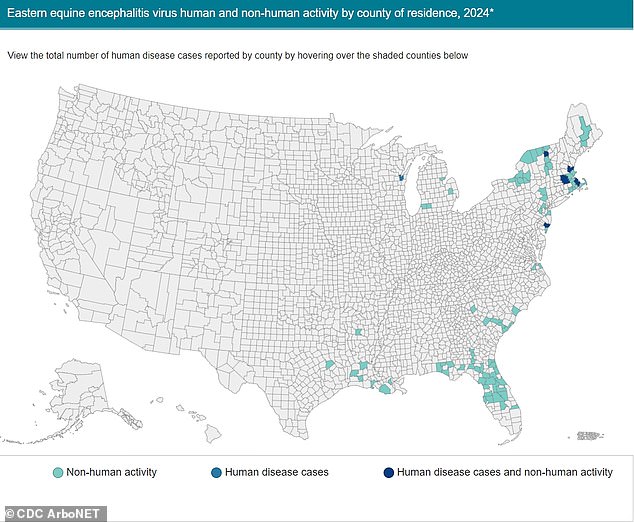How a THIRD state could issue ‘stay at home’ orders as it considers declaring the deadly virus a ‘public health emergency’
Maine officials are considering declaring a state of emergency in response to rising cases of deadly mosquito-borne diseases.
The state has recorded three cases of eastern equine encephalitis (EEE) in domestic animals and 15 cases of West Nile virus in wild birds.
Given the surge, a state health commission recommended declaring a state of emergency, which would allow the state to receive additional funding and implement “other interventions” to prevent the spread.
If the order goes into effect, Maine could follow neighboring Massachusetts and Vermont, which are also seeing similar increases. Authorities there have issued “strong recommendations” to stay indoors at night and have canceled nighttime events.
Experts hope that by urging residents to stay indoors, they can reduce the risk of exposure to the virus.
People who contract EEE usually experience a mild fever, chills, and body aches. About 30 percent of cases become more severe—leading to brain swelling and death. People infected with West Nile often have no symptoms, but about 20 percent develop a rash, and less than one percent of people die from the disease.
Several different types of mosquitoes can transmit this virus, but a common species is the cattail mosquito, whose scientific name is Coquilleta perturbans. This mosquito is found in the eastern and midwestern United States
The animals that tested positive for EEE, a horse and two emus, are located in Somerset and Penobscot counties in Maine.
There have been no human cases recorded in Maine. The CDC estimates that EEE infects 11 Americans per year — and six have been reported so far this year.
One person has died. New Hampshire resident and father Steven Perry, 41, died after contracting the virus last month.
In response to the positive EEE tests, Maine’s Arboviral Public Health Panel, which deals with mosquito-borne diseases, has recommended that Governor Janet Mills declare a public health emergency. Portland Press Herald reported.
This statement would likely help the state respond to the virus, Dr. Stefanie Bolas, a veterinarian from Maine, said: told WGME.
For example, this could mean making more money available for monitoring mosquitoes suspected of being infected and raising public awareness about these insects.
A public statement can also provide communities with the opportunity to implement other intervention measures.
While the details of this declaration are unclear, public health officials have indicated that it is different from the declaration the state issued in 2020 in response to the COVID-19 virus.
If Governor Mills were to issue this declaration, Maine would be the first state to declare the EEE situation a public health emergency.
Other states with resurgent viruses have opted for milder recommendations, issuing “strongly recommended warnings” about staying indoors after dark and closing public events.
In Vermont, public health officials have shut down one of the state’s largest annual celebrations — a local version of Oktoberfest — after 47 groups of mosquitoes carrying EEE were found in 11 communities.
In 2023, the same control group found just 14 groups of mosquitoes in three cities — a sharp increase, even though only one person actually tested positive for the virus. The Vermont Department of Health “strongly recommended” that people in the state stay indoors between 6 p.m. and 6 a.m.
In Massachusetts, only one person has contracted EEE, but several cities in the state have issued curfews, recommendations that ask people to stay indoors between 8 p.m. and 6 a.m.
Bay State residents were annoyed when local courts suggested they plan to enforce the curfew, a measure that could impact after-school programs and sports events.
While there have not yet been any human cases of EEE in Maine, the animal cases are concerning enough to warrant attention, Dr. Bolas said.


The CDC maintains a national registry of reported cases of EEE found in animals and reports them live on their website. Most cases this year have been concentrated in the Northeast. The map shows totals as of September 9, 2024
Dr. Bolas told WGME: “When we see activity in horses, it’s a warning to people that something is going on and they too need to take precautions.”
She stressed that people can only get the virus directly from a mosquito and that they do not need to worry about contact with horses.
“A horse itself poses no danger to people or other horses,” she said.
There is no vaccine or specific treatment for EEE. People who contract the virus usually take four to ten days to develop symptoms.
Typically, it involves mild fever, chills, body aches and joint pains that disappear within a few weeks. In 33 percent of cases, the virus infects the brain or spinal cord, which can lead to long-term disability and death.
People under 15 and over 50 are at greatest risk of serious illness.
Since there are no tailored medical treatments for the disease, authorities stress that avoiding mosquitoes is the best way to prevent getting sick.
If you must go out at night, they recommend wearing long clothing, using insect repellent and avoiding stagnant water, as this is where insects like to breed.
Officials are unsure why there have been increasing cases of a variety of mosquito-borne diseases in the area in recent years, including West Nile virus.
Maine Department of Environment and Community Health experts have linked the mass spread to climate change, as warmer, wetter climates provide more favorable breeding grounds for the insects.
